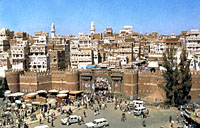
Sana’a: The city of white [Archives:2003/647/Culture]
July 3 2003
 |
 |
For the Yemen Times
A garden of blossoms is about to open and shine. A thousand butterflies are scattered on the horizon. As rainbow drinks the clouds, lights dance like moons in a river. Sana'a is spring, summer and winter
The summer sunset pours soft apricot light on the walls and rooftops of what is probably the world oldest continuously inhabited city. Viewed from the cool heights there is nothing remarkable about the streets of Sana'a. They slide through or dwindle into alleyways of the ancient quarter. It is when you descend from the hilltop and begin to walk the streets and alleys of the ancient Sana'ani capital that they reveal themselves as an ever changing people stage upon which the city displays its unique character. On busy avenues and quiet shaded lanes Sana'a buys and sells, boils, and plays, celebrates life and morns its passing. And with each season come changes in the colors, moods, and rhythm of the cities streets. Lights flash on the amusement rides, restaurants music blasts from speakers. After the sun goes down the city becomes alive.
The sun rises on streets empty of strollers, vendors or even cats. A man and his mule come into view, a produce vendor riding into the city from his farm nearby. Flat breads, onions, potatoes, tomatoes and watermelons, jasmine and incense, raisins with the color of henna, papayas and mangos from the Tehama, melons from Saadah, rose water in bottles, grapes and dates, almonds and nuts, and coffee beans and spices.
All have come from its green geometric terraces and valleys.
Schoolchildren soon appear. Some were walking, others waiting for buses. A man gathers sweetened jasmine blossoms as he walks down the sidewalk. Further at Tahrir square where old and new Sana'a meet, the street offers photocopying and photography services. The best place for open air photography is Tahir square. The place is awash with tourist, local and foreign. Both have their pictures taken, with plastic roses behind. The side walks around Tahrir are thick with goods and services. Shoe shines, nuts, dried seeds, grilled meat, tea and coffee. Watches, textiles. Street side stands are selling fresh squeezed juices. The fruit of the season serves as its own advertisement. Oranges, pomegranates, bananas, grapes, melons, mangos. The smell of jasmine and incense, a longing for past and its purity…
The streets and alleys of the old city begin to bustle once again as the setting sun loses its strength and the shadows strengthen. Merchants chew delicious green leaves of qat. The songs rise above the dust and the mingled smells of meat and garlic and apricots, grapes, raisons, and spices. The Rhythm of the street quickens. Shop keepers spot passing tourists. Local made colorful cloths are on display. The perfume vendors in front of the Grand mosque dispenses a hundred scents some as ancient as the trade routes from the East, others as modern as yesterday Paris fashion. By the time the day's final call to prayer fades away the market streets are calm at last. After the sun has set in the watches of the night, the God of Moon whitens the faces.
Moon, stars, clouds
But the old city rises early the next morning with more bustles, more color, and more voices. Shopkeepers these days tend to do their own sprinkling. Clothing vendors hang long night gowns, scarves, blouses. Beans, lever, fish, kebabs, eggs, cheese are breakfast food in Sana'a. Children pile into school buses. Mini buses decorated with advertisements. Bicyclists, scooters, pedestrians, all view for a place on the road. Traffic policemen whistle and wave.
Eid festivals, Ramadan, and pilgrimage to Mecca.
Falcons and pigeons.
Almonds, raisins and nuts
During feast days, those are times for family for cooking and eating and for visiting loved ones, children rule the streets. Only candy shops are opened, and young ones in beautiful new clothes parade the streets.
Once again the roads that waited have gone to sleep. Dust has wiped out all the footsteps. It is a little cold, a little quiet. Look at the sky and feel the air. Stars are dripping incense and spices. They return at dawn with news of the world. Passed ancient trees, wild flowers and roses. Past butterflies drifting through the air. Like happy messengers, it is still a little cold, a little quiet.
Spring brings warmth back to the city. The skies become cloudy and the nights cooler. Expectation of rain, sun and flowers. Flowers real or plastic are for weddings, for parties, for funerals, for love and hope, for sadness and regret. A procession winds slowly towards the commentary through the streets of the old city. Past branches filled with apricots. Passed houses leaning upon each other.
It is a great city – our fathers have told us that existed of old – a city of rich and treasure. Sana'a has lived a thousand years and it is yet to be born.
——
[archive-e:647-v:13-y:2003-d:2003-07-03-p:culture]


